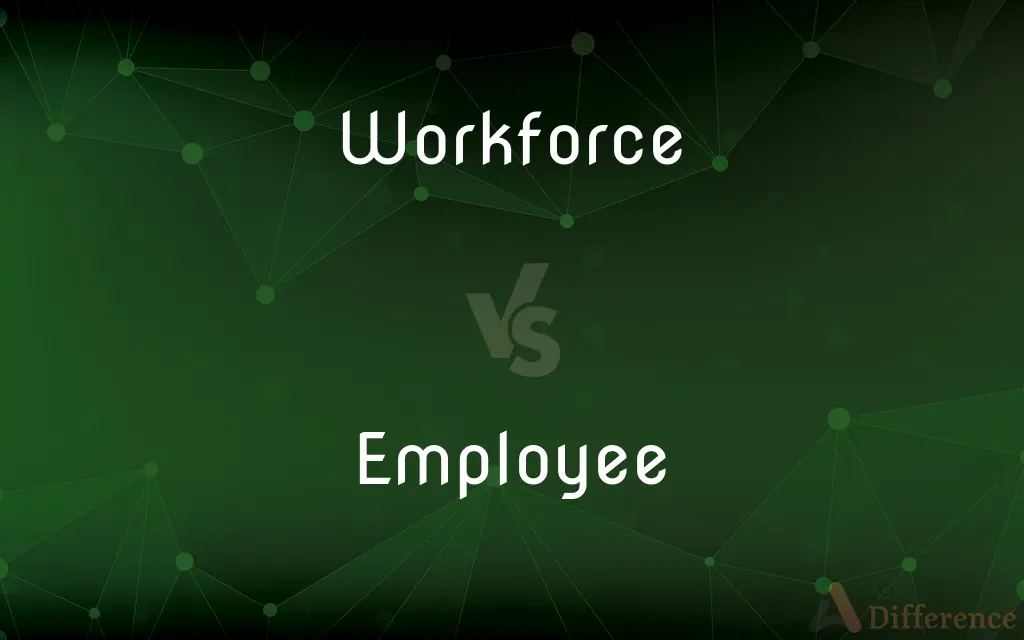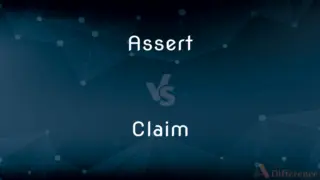Workforce vs. Employee — What's the Difference?
Edited by Tayyaba Rehman — By Maham Liaqat — Updated on April 8, 2024
The workforce encompasses all individuals working in a specific sector or company, while an employee is an individual hired to perform specific duties.

Difference Between Workforce and Employee
Table of Contents
ADVERTISEMENT
Key Differences
The term "workforce" refers to the collective group of individuals engaged in work within a specific sector, organization, or economy. It includes all types of workers, such as full-time, part-time employees, contractors, and freelancers, depending on the context. In contrast, an "employee" specifically denotes an individual who is hired and paid by an employer to perform specific tasks or services under certain conditions of employment.
Workforce is a broader term that captures the entire pool of labor available to an organization or economy. It reflects the capacity for labor and productivity at large. On the other hand, an employee is a narrower concept that focuses on the relationship between a single worker and their employer, typically involving contractual obligations, rights, and benefits specific to their employment status.
The composition of a workforce can reveal much about an organization's scale, diversity, and capabilities, including the range of skills, professions, and demographics represented. Meanwhile, the status of being an employee carries implications for job security, workplace rights, and access to benefits such as health insurance, paid leave, and retirement plans, which may not be equally available to all members of the workforce.
Management strategies and policies are often designed with the entire workforce in mind, aiming to optimize productivity, morale, and retention across all worker categories. In contrast, employee relations focus on engaging with individual workers or groups of employees, addressing their specific needs, grievances, and development paths within the framework of their employment.
The distinction between workforce and employee becomes particularly relevant in discussions about labor laws, economic policies, and human resource practices. For instance, regulations concerning the workforce may encompass broader labor market interventions, while those targeting employees specifically address the contractual and legal aspects of employment relationships.
ADVERTISEMENT
Comparison Chart
Definition
Collective group of individuals engaged in work
An individual hired by an employer
Scope
Broad, includes all types of workers
Narrow, focuses on specific individuals
Implications
Reflects labor capacity and diversity
Involves specific rights and obligations
Focus in Management
Overall productivity and morale
Individual needs and relations
Relevance
Labor market, economic policies
Employment law, contractual relations
Compare with Definitions
Workforce
Subject to changes based on economic and organizational needs.
The workforce was expanded to meet increased production demands.
Employee
An individual hired to perform duties.
Each employee receives a detailed job description upon hiring.
Workforce
The total number of people available to work.
The company’s workforce has doubled in the last five years.
Employee
Focus of individualized HR practices.
Employee performance reviews are conducted annually to discuss achievements and areas for improvement.
Workforce
Includes employees, contractors, and freelancers.
The workforce comprises both full-time employees and part-time consultants.
Employee
Engages in a contractual relationship with the employer.
The employee signed a two-year contract with the company.
Workforce
Reflects the demographic and skill diversity.
A diverse workforce can drive innovation and creativity.
Employee
Entitled to specific benefits.
Employees are eligible for health insurance after three months of service.
Workforce
Managed through policies affecting groups.
Workforce development programs aim to enhance skills across the organization.
Employee
Has obligations towards the employer.
Every employee is expected to adhere to the company’s code of conduct.
Workforce
The workforce or labour force is the labour pool either in employment or unemployed. It is generally used to describe those working for a single company or industry, but can also apply to a geographic region like a city, state, or country.
Employee
One employed by another.
Workforce
The workers employed in a specific project or activity.
Employee
A person who works for another in return for financial or other compensation.
Workforce
All the people working or available to work, as in a nation, company, industry, or on a project.
Employee
An individual who provides labor to a company or another person.
One way to encourage your employees to work harder is by giving them incentives.
Workforce
All the workers employed by a specific organization or state, or on a specific project.
Employee
A worker who is hired to perform a job
Workforce
The total population of a country or region that is employed or employable.
Workforce
The force of workers available
Common Curiosities
Do all members of the workforce have the same rights?
Not necessarily. Rights and benefits can vary significantly between employees, freelancers, and contractors.
How does the size of the workforce impact a business?
The size of the workforce can affect a business’s ability to meet demand, innovate, and expand its operations.
Is a contractor considered part of the workforce?
Yes, contractors are considered part of the workforce, although they are not employees in the traditional sense.
How are employees compensated for their work?
Employees are typically compensated with a salary or wages, along with potential bonuses, benefits, and other forms of remuneration.
What legal protections do employees have?
Employees are protected by various labor laws regarding wages, discrimination, safety, and wrongful termination.
What factors contribute to workforce diversity?
Workforce diversity can include a variety of factors such as age, gender, ethnicity, educational background, and professional skills.
How do changes in the economy affect the workforce?
Economic changes can impact hiring trends, wage levels, and the demand for certain skills within the workforce.
How can businesses improve their workforce management?
Improvements can be made through training, development programs, effective communication, and strategies that align with business goals.
Can the term employee include part-time workers?
Yes, part-time workers are considered employees, although their benefits and hours may differ from full-time employees.
Can a company have a workforce without any employees?
Yes, a company can operate with freelancers, contractors, and outsourced services, technically having a workforce without traditional employees.
What is the importance of employee engagement?
Employee engagement is crucial for morale, productivity, and retention, affecting overall business performance.
What challenges do companies face with workforce planning?
Challenges include predicting future labor needs, managing workforce diversity, and adapting to technological changes.
What role does HR play in managing the workforce?
HR plays a critical role in recruiting, training, and retaining the workforce, as well as ensuring compliance with labor laws.
Are freelancers and gig workers considered employees?
While part of the workforce, freelancers and gig workers are generally independent contractors, not employees, and have different rights and obligations.
How does workforce diversity benefit a company?
Diversity can enhance creativity, problem-solving, and market competitiveness by bringing a wide range of perspectives.
Share Your Discovery

Previous Comparison
Assert vs. Claim
Next Comparison
Away vs. HomeAuthor Spotlight
Written by
Maham LiaqatEdited by
Tayyaba RehmanTayyaba Rehman is a distinguished writer, currently serving as a primary contributor to askdifference.com. As a researcher in semantics and etymology, Tayyaba's passion for the complexity of languages and their distinctions has found a perfect home on the platform. Tayyaba delves into the intricacies of language, distinguishing between commonly confused words and phrases, thereby providing clarity for readers worldwide.
















































